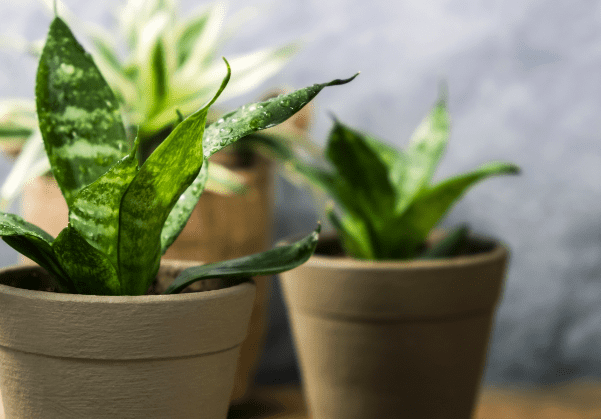
The snake plant or Sansevieria is commonly known among houseplant lovers as ‘Mother-in-Law’s Tongue’. Snake plants have long, sturdy leaves that resemble a sword, which is what attracts plant lovers to them as a decorative plant for the home.
Many people wonder what snake plant natural habitat is because they are an easy-to-care-for plant. Snake plants are native to Africa and Southern Asia. In case you’re curious about the snake plant’s origins, let’s look at some facts below.
Snake Plant Natural Habitat Are Naturally Found in the Wild
Normally found in the wild in South Asia, Africa and Madagascar, snake plants are native to these regions. It has been noted that many kinds of snake plants are similar to agave, yucca, and others that originate in the New World.
As with other plants of arid regions, Sansevieria developed CAM photosynthesis as a way to survive heat and drought. During daytime, their stomata open and lose precious water to high temperatures, but at night they precisely open them to store carbon dioxide in the form of an organic acid.
As the sun rises the next day, the snake plants close the stomata and benefit from the acid-stored carbon.
Sometimes Found Under the Large Tree or Shrub
Snake plants are sometimes found growing under dappled shade from a large tree or shrub. Snake plants are also classified as forest habitats by some people. In most varieties, if not all, they live several decades when they’re given the right conditions. These are just a few of the reasons why they are such hardy houseplants.
Various Sansevierias show up in a variety of growth forms. Most houseplant enthusiasts are familiar with the form typified by Sansevieria trifasciata.
The leaves of this snake plant tend to take the shape of a sword, while being long and narrow. Other Sansevieria varieties like Sansevieria subspicata and Sansevieria ballyi have a rosetted form with leaves ranging from thin to extremely succulent.
Many other species, such as Sansevieria grandis and Sansevieria forskalii, produce much larger, flattened leaves that resemble leaky vases.
Snake Plants’ Type
The snake plant is found in tropical and subtropical regions of Asia, Africa, and Europe, and roughly 70 different kinds are known to exist. The evergreens can grow anywhere from 9 inches (20 cm) to 12 feet (3.5 cm).
Sansevieria trifasciata is the most commonly used snake plant variety for gardening. To know more varieties of snake plants, besides Sansevieria trifasciata, this post will also show you other types of snake plants that you should know, here are the following:
Sansevieria ‘Golden Hahnii’
It is one of the snake plant varieties that has short leaves and yellow borders.
Sansevieria cylindrical
The Sansevieria cylindrical or cylindrical snake plant has dark green, round and striped leaves that can grow to 2 to 3 feet (61-91 cm).
Sansevieria trifasciata ‘Twist’
The leaves of this snake plant are twisted and horizontally striped, as the name implies. This plant grows to about 14 inches (35.3 cm) tall and has yellow variegated edges.
Sansevieria desertii
‘Rhino Grass’ grows to a height of 12 inches (30+ cm) with red-tinged leaves.
Sansevieria trifasciata ‘Bantel’s Sensation’
This plant is also known as the white snake plant, which grows up to 3 feet tall and has narrow leaves with white vertical stripes.
A majority of Sansevieria varieties undergo a radical transformation with age, regardless of how they grow. Sansevieria fischeri is a variety that illustrates this beautifully. What is the reason? This is because Sansevieria fischeri grows in tight rosettes of thick and mottled leaves when it’s young.
Eventually, these plants continue to grow until they reach surprisingly large sizes. Snake plants reach maturity when they are fully grown. The plant then turns from its rosette form into single leaves that protrude straight up from the ground, reaching heights of several feet. Rotting rosettes leave no trace of the plant’s former form.
Many Sansevieria plants can grow to colossal sizes if we are patient. However, enormous sizes are rarely observed as poor housing conditions and slow growth rates hamper their performance. In any case, it may be okay, considering that Sansevieria will be difficult to manage in a home once fully grown. Alternatively, your snake plants may flower rapidly if you’re lucky.
Sansevieria forms flowers in a simple race or in a branched race, though there is some variation among varieties. Flowers range in color from greenish white to brown. A large amount of nectar will then be produced by all. Occasionally, some captive specimens can emit an unpleasantly sweet smell from their flowers. Flowers become bright berries after pollination, marking their place in the Asparagaceae family.
Snake Plants’ Popularity
Currently, the houseplant hobby is experiencing a revival. Having gained popularity on a variety of social media platforms, easy-to-grow plants and their cultivars are rapidly gaining a level of popularity that we haven’t seen in decades.
Sansevieria is a genus of particular interest to houseplant lovers. Sansevieria species commonly found in cultivation go by common, less appealing names despite their popularity.
They are commonly known as Devil’s tongue, Mother-in-law’s tongue, and snake plant, which are negative names for what is actually the most forgiving houseplant on the market. Some houseplant growers have discovered that the dense groves of upright striped leaves hidden away in dark corners of their homes belong to a fascinating genus.
